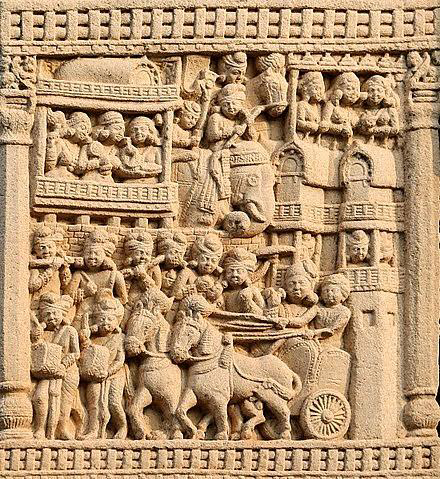In the Mahajanpadas, the roles and status of women varied across different regions and time periods. Here's a general overview of the social, warrior, and queenly aspects of women in the Mahajanpadas:
Social Roles:
सामाजिक भूमिकाएँ:
Household:
Like in many ancient societies, women in the Mahajanpadas primarily played roles within the household. They were responsible for managing the household, raising children, and performing domestic duties.
गृहस्थी:
कई प्राचीन समाजों की तरह, महाजनपदों में भी महिलाएँ मुख्य रूप से घर के भीतर भूमिकाएँ निभाती थीं। वे घर का प्रबंधन, बच्चों का पालन-पोषण और घरेलू काम-काज के लिए ज़िम्मेदार थीं।
Economic Activities:
Some women may have been involved in economic activities like farming, weaving, and trade, especially in regions where the economy was more diverse.
आर्थिक गतिविधियाँ:
कुछ महिलाएँ खेती, बुनाई और व्यापार जैसी आर्थिक गतिविधियों में शामिल रही होंगी, खासकर उन क्षेत्रों में जहाँ अर्थव्यवस्था अधिक विविध थी।
Warrior Women:
While the majority of women likely did not engage in warfare, there are historical references to female warriors in ancient India. These women were exceptions rather than the norm.
योद्धा महिलाएँ:
हालाँकि ज़्यादातर महिलाएँ युद्ध में शामिल नहीं होती थीं, फिर भी प्राचीन भारत में महिला योद्धाओं के ऐतिहासिक संदर्भ मौजूद हैं। ये महिलाएँ आदर्श न होकर अपवाद थीं।
Examples:
The most famous example is Rani Padmini of Mewar, who is often associated with valor and bravery in the defense of her kingdom.
उदाहरण:
सबसे प्रसिद्ध उदाहरण मेवाड़ की रानी पद्मिनी का है, जिन्हें अक्सर अपने राज्य की रक्षा में वीरता और बहादुरी के लिए जाना जाता है।
Queens and Female Rulers:
Some Mahajanpadas saw women ascend to positions of power as queens and rulers. These women had significant influence over their respective regions.
रानियाँ और महिला शासक:
कुछ महाजनपदों में महिलाएँ रानियों और शासकों के रूप में सत्ता के पदों पर आसीन थीं। इन महिलाओं का अपने-अपने क्षेत्रों पर महत्वपूर्ण प्रभाव था।
Examples:
Queen Vaishali of the Lichchhavi Republic is one notable example. She was known for her wisdom and governance skills.
उदाहरण:
लिच्छवि गणराज्य की रानी वैशाली इसका एक उल्लेखनीय उदाहरण हैं। वे अपनी बुद्धिमत्ता और शासन कौशल के लिए जानी जाती थीं।
Political Influence:
Some women from prominent families held positions of power and influence. They often acted as advisors to rulers or even ruled in their own right.
राजनीतिक प्रभाव:
कुछ प्रतिष्ठित परिवारों की महिलाएँ सत्ता और प्रभाव के पदों पर थीं। वे अक्सर शासकों की सलाहकार के रूप में कार्य करती थीं या यहाँ तक कि अपने दम पर शासन भी करती थीं।
Cultural and Religious Roles:
Women played significant roles in preserving and promoting the cultural and religious practices of their societies. They were involved in religious ceremonies, rituals, and the transmission of knowledge.
सांस्कृतिक और धार्मिक भूमिकाएँ:
महिलाओं ने अपने समाज की सांस्कृतिक और धार्मिक प्रथाओं के संरक्षण और संवर्धन में महत्वपूर्ण भूमिका निभाई। वे धार्मिक समारोहों, अनुष्ठानों और ज्ञान के प्रसार में शामिल थीं।
Diplomacy and Alliances:
Marriages were an essential tool for creating alliances between different Mahajanpadas. Women often played a key role in these diplomatic efforts, contributing to political stability.
कूटनीति और गठबंधन:
विभिन्न महाजनपदों के बीच गठबंधन बनाने के लिए विवाह एक आवश्यक साधन थे। इन कूटनीतिक प्रयासों में अक्सर महिलाएँ महत्वपूर्ण भूमिका निभाती थीं और राजनीतिक स्थिरता में योगदान देती थीं।
Education and Scholarship:
Although limited, some women were involved in scholarly pursuits and education, contributing to the intellectual growth of their societies.
शिक्षा और छात्रवृत्ति:
हालांकि सीमित, कुछ महिलाएं शैक्षणिक गतिविधियों और शिक्षा में शामिल थीं, और अपने समाज के बौद्धिक विकास में योगदान दे रही थीं।
It's important to note that the roles of women in the Mahajanpadas were diverse, and they were often influenced by factors like social class, region, and cultural practices. Moreover, historical records from this era are limited, so our understanding is based on available archaeological and textual evidence.
यह ध्यान रखना ज़रूरी है कि महाजनपदों में महिलाओं की भूमिकाएँ विविध थीं और वे अक्सर सामाजिक वर्ग, क्षेत्र और सांस्कृतिक प्रथाओं जैसे कारकों से प्रभावित होती थीं। इसके अलावा, इस युग के ऐतिहासिक अभिलेख सीमित हैं, इसलिए हमारी समझ उपलब्ध पुरातात्विक और पाठ्य साक्ष्यों पर आधारित है।

Great effort 🤟
ReplyDelete